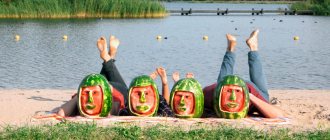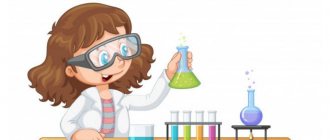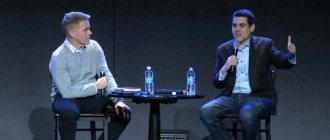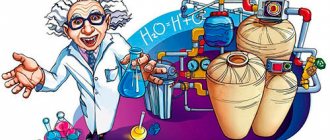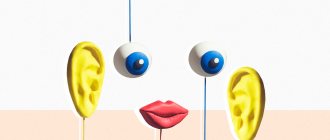The concept of observation as a research method
One of the most common and frequently used research methods is observation.
This method of cognition is easy to use, does not require additional costs, etc. To obtain the most accurate information, the observation method is used in combination with other methods, such as conversation, experiment, etc. Definition 1
Observation is a planned and purposeful perception of an object, process, phenomenon, etc., the results of which are recorded by the researcher (observer).
The essence of observation is the accurate and complete recording of facts obtained through the senses (vision, hearing, etc.), knowledge, skills and life experience.
Are you an expert in this subject area? We invite you to become the author of the Directory Working Conditions
Thus, observation is an active form of sensory cognition, the purpose of which is to accumulate facts and initial ideas about the object of study.
An important feature of observation is that it is closely related to thinking. The researcher conducting the observation must be able to analyze, isolate the important from the general, and group facts, properties, phenomena and signs. In addition, observation is inseparable from speech, that is, the ability to accurately and completely describe what is seen. If the obtained facts are described sparingly or insufficiently, then the value of the information received will be unscientific and low.
Note 1
So, the observation method can be used by a researcher who has developed powers of observation, thinking, and the ability to accurately and completely express phenomena and events.
Despite the fact that the observation method seems simple, its implementation requires not only certain knowledge and skills from the researcher, but also long and serious preparation.
Finished works on a similar topic
Coursework Observation as a research method 480 ₽ Abstract Observation as a research method 270 ₽ Test paper Observation as a research method 240 ₽
Receive completed work or specialist advice on your educational project Find out the cost
The purpose of observation is to study the characteristic features and changes of a certain phenomenon, object or action that are located in specific conditions. The results of the phenomenon largely depend on the level of preparedness and experience of the researcher.
One of the features of observation is that the results depend on the subjective attitude of the researcher to the object of observation. That is why observation must be combined with other research methods. A complex combination of methods guarantees obtaining the most objective result.
General information
A survey can be considered as one of the most common methods of obtaining information about subjects - survey respondents. A survey involves asking people specific questions, the answers to which allow the researcher to obtain the necessary information depending on the objectives of the study. One of the peculiarities of the survey is its widespread nature, which is caused by the specifics of the tasks that it solves. The mass character is due to the fact that a psychologist, as a rule, needs to obtain information about a group of individuals, and not study an individual representative.
Surveys are divided into standardized
and
non-standardized
. Standardized surveys can be thought of as rigorous surveys that primarily provide a general understanding of the problem being studied. Non-standardized surveys are less strict than standardized ones; they do not have strict boundaries. They allow the researcher's behavior to vary depending on the respondents' reactions to the questions.
When creating surveys, first, program questions are formulated that correspond to the solution problem, but which are understandable only to specialists. Then these questions are translated into questionnaires, which are formulated in a language understandable to a non-specialist.
Types of surveillance
Classification of observation as a research method.
According to the researcher’s involvement in the observation process:
- Direct observation is a type of observation in which the researcher is directly involved in the process under study, that is, acts together with the subjects. The degree of involvement of the researcher in the process may vary:
- the researcher is on the sidelines and is not part of the group of participants;
the researcher takes an active part in the research process together with the participants.
- Indirect observation (indirect) is a type of observation in which the researcher is not directly involved in the process. For example, a researcher observes how subjects perform an independent task (solving a problem, putting together a puzzle, etc.).
- Self-observation is a process that consists of contemplating one’s own internal processes and their external manifestation. For example, the teacher’s task to take a self-photo of his own work week, that is, to write down all the things that the subject did during the week, could serve as self-observation.
Note 2
The complexity, and at the same time, the uniqueness of the method of introspection lies in the fact that the researcher must “penetrate” his own mental processes and phenomena. Its complexity lies in the fact that sometimes it is difficult for the researcher to express his feelings and experiences.
By duration of observation:
- Systematic observations are carried out regularly during a specific time period (period).
Systematic observations can be:
- long-term
continuous,
- cyclical.
- Non-systematic observations - carried out if necessary. Most often, they are not organized in advance; observation is carried out for an unexpected situation or phenomenon.
According to the observation form:
- Mindful observation. With this form of observation, the subject knows that he is being observed, he knows the purpose and objectives of the observation. However, sometimes there may be a situation in which the subject is told a different purpose and objectives of the observation. This need may be due to ethical standards or certain research problems.
- Unconscious observation. With this form of observation, the subject does not know about the research being conducted. The observer is inside the system under study, that is, he is introduced into it in order to obtain reliable information. It is important that subjects should not in any way be aware of the role of the observer. Most often, unconscious observation is used in social pedagogy to study the social behavior of small groups.
Note 3
Thus, observation as a research method has several types. The choice of type of observation depends on the purpose of the study and the characteristics of the objects and phenomena being tested.
Disadvantages of the observation method
- Numerous irrelevant, interfering factors. Observation results may be influenced by the mood of the observer,
- the social position of the observer in relation to the observed,
- observer's bias
- complexity of observed situations,
- first impression effect,
- fatigue of the observer and the observed,
- errors in assessments,
- "halo effect"
- "leniency effect"
- averaging error (fear of extreme judgments),
- modeling errors,
- contrast error.
- The one-time occurrence of observed circumstances, leading to the impossibility of making a general conclusion based on single observed facts.
- The need to classify observation results.
- The need for large resource costs (time, human, material).
- Low representativeness for large populations.
- Difficulty in maintaining operational validity.
Object and subject of observation
The object of observation is individuals in various situations of social interaction or large and small groups, communities.
The subject of observation is the verbal and non-verbal acts of behavior of an individual, group or several groups in a certain social environment and situation:
- speech acts, their content, sequence, direction, frequency, duration, intensity, expressiveness, features of semantics, vocabulary, grammar, phonetics, synchronization;
- expressive movements, expression of face, eyes, body, sounds;
- movement, movements and stationary states of people, the distance between them, speed and direction of movement, contact;
- physical impact: touching, pushing, hitting, supporting, joint efforts, transferring, taking away, delaying;
- a combination of the listed characteristics.
Objective observation is aimed not at external actions in themselves, but at their psychological content. Here, the external side of activity and behavior is only the raw material of observation, which must receive its psychological interpretation and be comprehended within the framework of a certain theory.
The following stages of observation are distinguished.
Determining the goal, setting tasks, establishing the object and subject of observation. Depending on the goals of the study, one or a limited number of aspects of the object’s activity are usually selected as the subject of observation, for example, the route of movement of a buyer in the sales area of a store is studied.
Ensuring access to the environment, obtaining appropriate permits, making contacts with people.
Selecting an observation method and developing a procedure based on previously collected materials.
Before you begin observation, you need to select in advance signs, units of observation, by which you can judge the situation that interests the researcher. As a unit of observation (and from the side of the observed, it is a unit of behavior), any complex set of actions of a different nature can be identified and recorded, for example, a buyer can simply look at a certain product, or maybe even pick it up.
In order for observational data to be understandable to other researchers, and the results of similar studies to be comparable, it is necessary to develop a language, a system of concepts with the help of which the observational results will be described. For example, if there is a reaction to an advertisement in a store, then different types of manifestation of an emotional state (category) should be clearly identified and recorded: calm, excitement, etc.
Preparation of technical documents and equipment (replication of cards, protocols, instructions for observers, preparation of technical equipment, writing materials, etc.).
After developing the plan, observations are carried out, data is collected, and information is accumulated.
It is essential that each observer receives appropriate training. Observer training involves simultaneously developing the ability to see significant actions, as well as the ability to remember and keep accurate records.
Recording the results of observations , carried out in the form of: a) short-term recording, carried out “hot on the trail”, as far as space and time allow; b) cards used to register information regarding observed persons, phenomena, processes (in the observation protocol, which is an extended version of the card); d) an observation diary, in which all the necessary information, statements, behavior of individuals, one’s own thoughts, and difficulties are systematically recorded, day after day; e) photo, video, sound recordings.
Recording the results of observations is simultaneously a means of double control: control over the observer and control over possible deviations within the observed situation or process.
When developing an observation plan, it is necessary to determine the most significant characteristics of the conditions and situations in which the activities of the observed take place, i.e. decide where and at what time the observation should be carried out.
11. Experiment as a method of collecting primary marketing information.
Experiments conducted during marketing research provide significant assistance in establishing cause-and-effect relationships between marketing factors and the state of the objects under study. For example, in order to determine the relationship between consumer behavior and such marketing factors as product price, advertising, and sales promotion, it is necessary, by changing the latter, to monitor the dynamics of sales volumes.
An experiment is a method of collecting primary M.Information. by manipulating independent variables in order to determine their influence on dependent variables, subject to the exclusion of the influence of other (not studied) factors.
Independent variables are “variable factors (for example, prices, advertising costs, advertising content, etc.), which can change at the discretion of the researcher (experimenter), and the consequences (effect), the impact of which is subject to measurement and comparison. Independent variables are determined in accordance with the objectives of the study, including the hypothesis to be tested experimentally.
Dependent variables are factors that are expected (hypothetically) to change under the influence of independent variables. These may include, for example, sales volume, market share, profit, etc.
Methodologically, the experiment is aimed at identifying cause-and-effect relationships between independent (cause) and dependent (effect) variables. The logic of evidence of relationships between variables is based both on measuring the state of the research object before and after the experiment, and on the use of two groups of respondents or objects: an experimental group, which will be exposed to the influence of an independent variable (experimental factor), and a control group, with which the results of the experiments are compared. . The hypothesis is considered confirmed if the expected changes occurred in the experimental group, but not in the control group.
Experiments used in the practice of marketing research can be classified according to a number of characteristics.
According to the degree of materialization of the object of study, real, simulation and speculative (thought) experiments are distinguished.
Real experiments are carried out in natural settings on real-life objects. Such studies are characterized by significant time and financial costs, as well as significant dependence on the state and stability of the external environment. For example, while studying the reaction of consumers to a reduction in the price of a certain dish, competitors may take similar actions, which will distort the results of the experiment.
Simulation experiments involve the construction of models of the state of a particular object using economic and mathematical methods and computer information technologies. For example, market simulation testing involves the use of certain data about the marketing activities of the enterprise, which are entered into a model containing assumptions about the state of the market and the actions of competitors. As a result of such an experiment, various options for the development of the market situation are formed, depending on the marketing decisions made by the enterprise. Simulation experiments require much less time and money to implement than real ones. The disadvantages are associated with the limited capabilities of the model (the results depend on the initial data contained in it) and the scope of application (such experiments are applicable only for fairly well-studied processes).
Thought (speculative) experiments consist in the fact that instead of real objects, the researcher manipulates information about past or possible events. At the same time, the logic of analyzing the factors affecting the object is similar to that used in real experiments. However, the results of thought experiments, without having the evidentiary value of a real experiment, are essentially hypotheses that are subject to subsequent testing.
Depending on the scale of the task, single-factor and multifactor experiments are distinguished.
Single-factor experiments involve studying the influence of only one marketing factor on the dependent variable. For example, an enterprise can evaluate how a reduction in the price of the services offered will affect the volume of their sales.
Multivariate experiments are aimed at assessing the influence of several marketing factors on the dependent variable. Such studies are very complex, but they make it possible to measure the impact on certain processes and phenomena not only of individual factors, but also of their complex. To reduce the labor intensity and cost of conducting a multivariate experiment, statistical models are used.
Based on the nature of the environment, experiments are divided into laboratory and field.
Laboratory experiments are carried out under artificially created conditions in order to exclude the possibility of influence of side factors on the results obtained. They are usually carried out in specially equipped premises equipped with the necessary technical means. The established name for this form of experiment is “hall test” ; the name “studio test ” is also found. Such experiments, in particular, are used to assess the perception of new dishes in a restaurant, testing brand elements, advertising messages, prices, sales promotion events, etc.
Field experiments are carried out under real conditions. For example, a hotel chain marketer can evaluate the effectiveness of advertising in the following way. Several comparable markets are selected, in each of which advertising costs constitute approximately the same percentage of sales. Then, in one market, advertising costs decrease by a certain percentage, in another, on the contrary, they increase by the same percentage, and in the third they remain unchanged (these are control indicators). The data on changes in sales volumes obtained as a result of such an experiment can indirectly indicate the effectiveness of advertising.
An essential feature of field experiments is that they do not exclude the influence of side factors, and the degree of this influence is almost impossible to take into account and assess. In addition, field experiments require significant time to implement and are associated with high costs.
The location of the field experiment can be a hotel, restaurant, office of a tourism enterprise, various localities and geographic regions. There are also known experiments carried out at consumers’ homes and which have received the established name “home-test”.
Many field experiments are known as “test marketing.” The object of study during its implementation is various markets, therefore such activity is often called market testing. The main feature of market testing is that it is a controlled experiment in a limited but carefully selected market space with the purpose of predicting future sales or profits depending on one of several proposed marketing actions (introduction of new products, manipulation of elements of the marketing mix, advertising campaign, new marketing program, etc.). For example, McDonald's conducts similar experiments before introducing them to new markets (countries) to adapt its products to the tastes of local consumers.
A characteristic feature of market testing is the high cost of the experiment . In addition, the market in which such research is carried out must be adequate to the target in terms of the number and structure of consumers, and the state of competition.
The test should be so long that it is possible to take into account repeat purchases (in the optimal case, until they stabilize).
The quality of the primary M.Information obtained as a result of conducting experiments largely depends on their organization, which contains a number of procedures: determining the goals and objectives of the experiment;
selection of experimental factors (independent variables);
selection of dependent variables and indicators for their assessment; justification of the object and form of research;
preparation and conduct of experimental studies (including measuring the values of indicators of interest);
establishment and analysis of identified dependencies;
determination of the internal (boundaries within which the change in the dependent variable is actually due to the influence of the independent variable) and external (representativeness) reliability of the experimental results.
Main advantages of the experiment:
the ability to study cause-and-effect relationships between various M factors;
fairly high objectivity of the results obtained;
the ability to check the effectiveness of marketing decisions.
Disadvantages of the experiment:
high labor intensity, high time and financial costs;
the complexity of organizing and providing the necessary conditions for conducting it, excluding the influence of side factors on the results obtained;
the danger of errors in the interpretation of the results (attributing changes in one variable to another);
uncertainty about the applicability of experimental results in other situations and conditions;
the presence of a time lag between the completion of the experiment and the adoption of Mark's decisions.
Taking these features into account allows researchers to choose and effectively implement an appropriate form of experiment for the situation.
12.Marketing research of the internal environment of the enterprise.
A tourism enterprise operates in constantly changing conditions, determined by the variety of relationships that develop within it, as well as with other economic entities
. The totality of these relationships constitutes the concept of the marketing environment . It largely determines the nature of the company’s activities and must necessarily be considered in detail in the process of conducting marketing research. In order to determine a marketing strategy and implement it, management must have an in-depth understanding of: 1) the internal environment
of the tourism enterprise, its potential and development trends; 2)
the external environment,
its characteristics and the place occupied by the enterprise in it.
The internal environment (microenvironment ) is part of the general marketing environment that is located within the enterprise and is controlled by it. It contains the potential that allows a company to function, and, consequently, to exist and survive in a certain period of time. The internal environment is analyzed in the following areas: - personnel (their potential, qualifications; selection, training and promotion; evaluation of results labor and stimulation; preservation and maintenance of relations between employees, etc.); - management organization (communication processes; organizational structures; norms, rules, procedures; distribution of rights and responsibilities; hierarchy of subordination); - finance (maintaining liquidity, ensuring profitability , creation of investment opportunities); - marketing (tourist product strategy; pricing strategy; sales strategy; communication strategy). The purpose of studying the internal environment is to understand the strengths and weaknesses of the enterprise. The revealed strengths serve as the basis on which the enterprise relies in the competitive struggle and which it must expand and strengthen. Weaknesses should be the object of the closest attention. It is necessary to try to get rid of most of them. The internal environment determines the possibilities for the effective functioning of the enterprise. But it can also be a source of problems if it does not provide the necessary conditions for the integrated use of the marketing concept. If the actions of various services and personnel of the company are not united by a single marketing strategy, the “swan, crayfish and pike” effect may occur when, for example, individual divisions and employees are not interested in achieving overall marketing goals. This situation can be avoided if you try to raise the culture of the enterprise, which should be subjected to the most serious analysis in the process of M. research. The culture of an enterprise consists of many norms, rules and values that guide its activities. Culture covers the existing system of relations between people in an enterprise, the distribution of power, management style, personnel issues, and the determination of development prospects. The achieved level of culture can help an enterprise operate competently; the absence of culture, on the contrary, will hinder the normal implementation of its business behavior. Everything here matters - from the design of the office to the reaction of employees to this or that version of the marketing strategy. Since the culture of an enterprise does not have a clearly expressed manifestation, it is quite difficult to study .
However, there are a few consistent points that are important to clarify in order to try to highlight the strengths and weaknesses that culture brings to an enterprise. First, businesses with strong cultures tend to emphasize the importance of the people who work for them. Such enterprises pay great attention to explaining their corporate philosophy and promoting their values. Secondly, the culture of an enterprise can be judged by how it builds relationships with competitors and treats its customers. Thirdly, an idea of the culture of an enterprise is given by observing how employees work in their workplaces, how the career system is structured and what criteria are used to promote employees. Fourthly, understanding culture is facilitated by studying whether the enterprise has stable commandments, unwritten norms of behavior, how aware all employees are of this and how seriously they take them. If employees are well aware of the history of the company, take rules and symbols seriously and respectfully, then it can be highly likely that the enterprise has a strong culture. The particular importance of analyzing the culture of the enterprise is that it not only determines intra-company relationships, but also has a serious impact on how the enterprise builds its interaction with the external environment. 13.Marketing research of the external environment of the enterprise.
A tourism enterprise operates in constantly changing conditions, determined by the variety of relationships that develop within it, as well as with other economic entities
. The totality of these relationships constitutes the concept of the marketing environment . It largely determines the nature of the company’s activities and must necessarily be considered in detail in the process of conducting marketing research. In order to determine a marketing strategy and implement it, management must have an in-depth understanding of: 1) the internal environment
of the tourism enterprise, its potential and development trends; 2)
the external environment,
its characteristics and the place occupied by the enterprise in it.
The external environment is considered as a combination of two relatively independent subsystems : - macroenvironment; - immediate environment. Macroenvironment (macroenvironment ) creates the general conditions of the enterprise's environment. In most cases, the macroenvironment is not specific to an individual company. However, each of them experiences its influence and cannot control it. The study of demographic factors of the macroenvironment occupies an important place when analyzing the market opportunities of a tourism enterprise. Marketing should consider issues related to the size of the population, its distribution in individual countries and regions, the age structure, highlighting the working population, students and retirees. Thus, the tourism market for older people is currently the fastest growing. Demographic changes also affect families. Each group of the population, classified according to one demographic criterion or another, requires “its own” tour product. Each such group has its own budget, which should also be studied by marketing specialists. The group of demographic factors also includes urbanization, i.e. increasing the share of the urban population. Within one country, the degree of tourist activity in cities is much higher than in rural areas. Moreover, the larger the city, the greater the number of its residents go on tours. This is explained, first of all, by the fact that the main prerequisite for the development of mass forms of tourism in the second half of the 20th century. there was a need for rest (associated with a change of scenery, with travel), caused by overload and nervous tension, which are higher the larger the city. Having collected data on trends in demographic processes, it is possible to analyze their possible impact on the activities of a tour company, determine the areas of application of the main efforts and predict the results of future work. Economic factors are no less important than demographic ones. It is not enough to know how many potential clients a company has. It is also important to determine how many and what services they will want to purchase. The solvency process of the population is influenced by many factors, including the level of economic development of the country itself, the size of wages, inflation, and unemployment. It is necessary to take into account the high dependence of the demand for services on the level of income. Natural factors cannot but influence the activities of a tour enterprise, especially since the issues of rational use of natural resources and environmental protection become global. In addition, natural factors (climate, topography, flora and fauna) are the most important element in motivating customers to travel and attracting tourists to a particular region or country. Marketing of a tourism enterprise is influenced by socio-cultural factors . National KitchenAnalysis of scientific and technical factors allows us to timely see the opportunities that the development of science and technology opens up for the production of new types of services, their sales and improvement of customer service. Scientific and technological progress carries with it enormous opportunities and an equally serious threat to the company. Any innovations threaten with displacement, outdated technologies and methods of work, which is fraught with the most unpleasant consequences if due attention is not paid to the study of factors of a scientific and technical nature. Analysis of laws and other regulations that establish legal norms and the framework of relations gives an enterprise the opportunity to determine for itself the acceptable boundaries of action and acceptable methods of defending its interests. The immediate environment is represented by those components of the external marketing environment with which the enterprise is in direct interaction. It is important to emphasize that the company can have a significant influence on the nature and content of this interaction. Thus, it can actively participate in the formation of additional opportunities and the prevention of threats to its further existence. The first “among equals” in the immediate external environment of the company are, of course, consumers . Studying them allows us to better understand what services will be accepted by them to the greatest extent, what sales volume can be expected, and how much the circle of potential clients can be increased. The next most important component of the immediate external environment is competitors participating in the ongoing competition for consumer preferences. Almost no tour company is able to independently organize a tour, provide accommodation, organize meals, etc. BRINGING PRODUCTS FROM SUPPLIERS TO THE CAFE. relevant enterprises and organizations (“subcontractors”) are usually involved providing the missing links in comprehensive services. Relations with contact audiences have a significant impact on the activities of the enterprise. They represent groups of individuals, organizations, institutions that potentially or actually influence the activities of the company.
The potential impact can be expressed both in maintaining neutrality in relation to the company, and in showing a certain attitude towards it. The main contact audiences surrounding the travel company are: financial circles (banks, investment funds, financial, insurance companies and other financial and credit institutions) ; Media (press, radio, television); the public (consumer unions, public formations, as well as the population that does not act as any organized force, for example, residents of the resort area); the company’s personnel, on whose opinion about the activities of their enterprise their attitude to work depends. 14. Marketing market research.
The main goal of MI is to reduce uncertainty and risk when making commercial decisions. Complex MIs can be carried out independently, or they can be carried out by special MI companies. For MI to be effective, it should not be random in nature, be systematic, and cover as many different sources of information as possible.
MI is the systematic collection, recording and analysis of data about problems related to the marketing of products and services.
The tasks of MI are varied. When studying the hotel services market, we can distinguish the following types of tasks:
1) study of the characteristics of the hotel services market (suppliers, consumers, competitors);
2) assessment of the market potential of the enterprise and its market share;
3) sales analysis, existing sales channels; 4) study of business activity trends;
5) assessment of the financial and economic situation; 6) ongoing observations of target markets;
7) the degree of market saturation with services, the introduction of new services;
 forecasting long-term market development trends;
forecasting long-term market development trends;
9) studying the activities of competitors; 10) analysis of the degree of consumer satisfaction with services.
The methodological basis of MI consists of general scientific, analytical and prognostic methods, techniques borrowed from various fields of knowledge, as well as methods of marketing analysis itself.
General scientific methods: - systems analysis; - integrated approach; - program-target planning; - analytical and forecasting methods; - linear programming; - communication theory; - probability theory; - network planning; - business game methods; - economic and mathematical methods; - methods of expert assessments.
Methods of M analysis: - SWOT analysis; - segmentation; - positioning; - competitiveness assessment.
System analysis allows us to consider the market situation as an object of study that has a wide range of internal and external factors.
An integrated approach allows you to study the market situation as an object with various manifestations. System analysis and an integrated approach are closely interrelated and cannot be implemented one without the other.
Programmatic and targeted planning is necessary when developing and implementing marketing strategies and tactics.
Linear programming acts as a mathematical method for selecting optimal solutions with min costs and max income.
Communication theory examines the mechanism of feedback and allows you to obtain information about the processes and phenomena occurring in the market and characterizing the behavior of consumers, competitors, and intermediary suppliers.
Methods of probability theory make it possible to determine the probabilities of the occurrence of certain events and select the most preferable actions.
Network planning makes it possible to regulate the sequence of individual operations, record the main stages of work, determine deadlines, and delineate responsibilities.
The method of business games allows you to choose a “scenario” of behavior in various situations.
The method of expert assessments helps to obtain information about the prospects for business development, its strengths and weaknesses, and to evaluate the effectiveness of certain marketing activities.
Economic and mathematical methods make it possible to determine optimal marketing strategies and estimate optimal costs to obtain the required income.
The organization of MI must be structured in such a way as to ensure that it is comprehensive and systematic; in addition, a scientific approach must be observed in the implementation of MI.
In a generalized form, the MI process consists of stages:
1) defining the problem and setting MI goals; 2) selection of information sources;
3) collection and analysis of secondary information; 4) obtaining primary information;
5) data analysis, development of conclusions and recommendations; 6) presentation and implementation of the results obtained.
Defining the problem and setting research goals is the main, defining stage of MI, since a timely and correctly formulated problem significantly reduces the time to find ways to solve it and helps save material and financial resources.
There are several approaches to identifying current and future problems of the enterprise's living rooms.
Prospective problems:
— the problem of increasing market share, reaching new segments; — the problem of increasing the business activity of the enterprise; — problems of forming business development strategies.
Current issues:
— maximizing enterprise income; — development of new sales channels for hotel products and services;
— development of sales promotion programs; — development of new hotel products and services.
At the 2nd stage of MI, information sources are selected; this stage is carried out to facilitate the search for the necessary information. Information sources allow you to obtain two types of information - primary and secondary.
The third stage of MI is the collection and analysis of secondary information.
Secondary information is data collected previously for various purposes and existing independently of the problem being studied.
Secondary information is the starting point of MI. It is characterized by quick access to materials, its sources may contain data that the company is not able to obtain on its own, this information is distinguished by a wide selection of sources and a relatively low price. However, it may be incomplete, outdated, insufficiently reliable, and the methodology for collecting data may be unknown.
Sources of secondary information can be divided into two groups: internal and external.
Internal sources of information are directly related to the company. Internal information is contained in the following materials: budgets, profit and loss data, customer accounts, results of other research, sales reports, etc. In a hotel enterprise, this is a client database, contracts with clients, transport organizations, enterprises providing additional services, data from the analysis of hotel activities by position: average annual occupancy level, seasonal distribution of flows, average prices; statistical information, data on mutual settlements with travel agencies, information about clients (number, length of stay, etc.).
In addition, if a hotel company uses Yield management - a revenue management system, it must form a certain database, which consists of the following main elements:
— historical statistics of cancellations;
— historical no-show statistics (case of client no-show or late cancellation of a reservation). Moreover, data on no-show clients should be presented by segments;
— go-show historical statistics (go-show client buying a room without prior reservation, without discounts, at higher prices);
— historical statistics of sales refusals;
-the number of idle rooms and historical statistics of this indicator;
— the number of bookings over time and in distribution by segment;
— historical statistics of reservation periods;
— historical statistics of overall results: load percentage and ADR (average daily rate), which means “revenue received from sales”;
— historical information about past and proposed events (exhibitions, fairs, seminars, etc.).
External secondary information can be obtained from official publications of government and state institutions, commercial research organizations, the Internet, books, newspapers, magazines, monographs, reference books, television and radio; this information is also contained in statistical collections, laws and regulatory data.
Special publications dedicated to the hotel business: magazines “Five Stars”, “Hotel”, “You and Your Restaurant”, etc.
The next stage of MI is obtaining primary information.
Primary information is information that has just been obtained specifically to solve a specific problem under study. Primary data is collected in accordance with precise purposes; such information is quite reliable, but collecting and processing it requires significant material and labor costs.
There are the following methods of collecting primary data: observation, experiment, simulation, survey.
A timely marketing information system is required.
A marketing information system is a computer-based set of procedures and methods designed to create, analyze and disseminate information for proactive marketing decisions on a regular, ongoing basis.
15.Marketing analysis of competitors.
Competitor analysis is a necessary step in developing a marketing strategy.
The approximate structure of such a document :
1- identifying the company’s competitors; 2-defining the goals of competitors; 3-establishing competitors' strategies; 4-assessment of the strengths and weaknesses of competitors; 5-assessment of the range of possible reactions of competitors; 6-Selecting competitors to attack and avoid.


